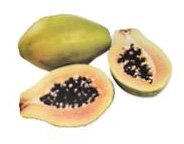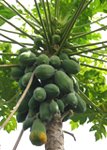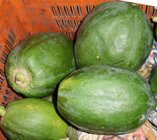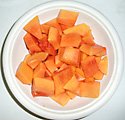Papaya fruit Nutrition facts
Deliciously sweet, papaya fruit is another gift of Mexicans to this world. This exotic fruit is packed with numerous health-benefiting nutrients. It is one of the favorites of fruit lovers for its nutritional, digestive, and medicinal properties. It is probably thought to have originated in the Central Americas.
Papaya plant is grown extensively all over the tropical regions under cultivated farms for its fruits as well as for latex, papain, an enzyme that found wide applications in the food industry.
Botanically, the plant belongs to Caricaceae family of flowering plants, in the genus; Carica.
Scientific name: Carica papaya.

|

|
| Papaya fruit. Note for orange color pulp and black seeds grouped at the central hollow space. | Papaya plant. Note for ripe papaya fruit. Young, immature fruits are developing at the crown end. Photo courtesy: Kamoteus |
The papaya tree bears many spherical or pear-shaped fruits clumped together near the top end of the trunk. They come in a variety of sizes ranging from 6-20 inches in length and 4-12 inches in diameter. The average-sized papaya weighs about a pound. The fruit is said to ripen when it yields to gentle thumb pressure, and its skin turns amber to an orange tint.
Inside, the fruit features numerous black peppercorn-like seeds, encased in a mucin coat concentrated at its hollow, central cavity as in melons. The flesh is orange in color with either yellow or pink hues, soft, and has a deliciously sweet taste with a rich, musky flavor.
Babaco fruit is closely related to papaya and has a similar appearance and flavor as papaya.
Papaya fruit health benefits
The papaya fruit is very low in calories (just 43 calories/100 g) and contains no cholesterol; nonetheless, it is a rich source of phytonutrients, minerals, and vitamins.
Papayas contain soft, easily digestible flesh with a good amount of soluble dietary fiber that helps to have normal bowel movements, thereby reducing constipation problems.
Fresh, ripe papaya is one of the fruits with the highest vitamin-C content (provides 60.9 mg or about 101% of DRI, more than that of in oranges, or lemons). Research studies have shown that vitamin C plays many vital roles like free radicals scavenging, boosting immunity, and anti-inflammatory actions.
It is also an excellent source of Vitamin-A (provides 950 IU/100 g) and flavonoids like β -carotene, lutein, zeaxanthin and cryptoxanthin.
Vitamin A is required for maintaining healthy mucosa and skin and is essential for healthy vision. These compounds are known to have antioxidant properties and thus, help act as protective scavengers against oxygen-derived free radicals and reactive oxygen species (ROS) that play a role in aging and various disease processes. Consumption of natural fruits rich in carotenes has been known to protect the human body from lung and oral cavity cancers.
Papaya fruit is also rich in many essential B-complex vitamins such as Folic acid, pyridoxine (vitamin B-6), riboflavin, and thiamin (vitamin B-1). These vitamins are essential in the sense that the body requires them from external sources to replenish and play a vital role in metabolism.
Fresh ripe papaya also contains a good amount of potassium (257 mg per 100 g) and calcium. Potassium is an important component of cell and body fluids and helps control heart rate and blood pressure countering the effects of sodium.
In some traditional medicines, papaya seeds are employed as a proven natural remedy for many ailments. The seeds can be found in applications as anti-inflammatory, anti-parasitic, and analgesic, and used to treat stomachache and ringworm infections.
| Principle | Nutrient Value | Percent of RDA |
|---|---|---|
| Energy | 43 Kcal | 2% |
| Carbohydrates | 10.82 g | 8% |
| Protein | 0.47 g | 1% |
| Total Fat | 0.26 g | 1% |
| Cholesterol | 0 mg | 0% |
| Dietary Fiber | 1.70 g | 4% |
| Vitamins | ||
| Folates | 37 µg | 9% |
| Niacin | 0.338 mg | 2% |
| Pantothenic acid | 0.218 mg | 4% |
| Pyridoxine | 0.038 mg | 3% |
| Riboflavin | 0.027 mg | 2% |
| Thiamin | 0.023 mg | 2% |
| Vitamin A | 950 IU | 32% |
| Vitamin C | 60.9 mg | 102% |
| Vitamin E | 0.30 mg | 2% |
| Vitamin K | 2.6 µg | 2% |
| Electrolytes | ||
| Sodium | 8 mg | 0.5% |
| Potassium | 182 mg | 4% |
| Minerals | ||
| Calcium | 20 mg | 2% |
| Iron | 0.25 mg | 3% |
| Magnesium | 21 mg | 5% |
| Phosphorus | 10 mg | 1% |
| Zinc | 0.08 mg | 0.5% |
| Phyto-nutrients | ||
| Carotene-β | 276 µg | -- |
| Crypto-xanthin-β | 761 µg | -- |
| Lutein-zeaxanthin | 75 µg | -- |
Selection and storage
Mature Papaya usually is harvested once its skin slightly turns yellow. Organic Papayas are normally left to ripen on the tree. However, care should be taken since over-ripe fruits fall off the tree on their own and get spoiled.

|
| Raw, unripe green papaya. |
In the markets, papayas come in various sizes and stages of maturity; therefore, select the one based on your serving size and timing. Choose the one with intact skin without any surface cracks, bruises, or cuts. Unripe fruits can be kept at room temperature for a few days, but ripe ones should be stored in the refrigerator. Bring it back to normal temperature when it is to be eaten to get its natural taste and flavor.
Unripe green papaya cooked as a vegetable in many Asian and Pacific regions. However, it should not be eaten raw as it contains toxic alkaloids in its milky latex.
Preparation and serving method
Wash papaya fruit thoroughly in cold running water to remove dirt and any pesticide residues. Skin is bitter in taste and inedible. Remove the skin with a "peeling knife," and cut the fruit longitudinally into two halves. Gently remove seeds and thin slimy layer loosely adhering to the flesh. Cut the fruit longitudinally into wedges or small cubes.
Here are some serving tips:

Ripe papaya fruit is usually eaten raw as it is or with a twist of lemon drops and seasoned with salt and pepper.
Fresh papaya cubes are a great addition to fruit salads.
Papaya juice with ice cubes is a favorite drink.
Its cubes can be used in shakes, sorbets, salsa, etc.
Ripe fruit also goes well with chicken and savory seafood dishes.
Unripe green papaya can be used as a vegetable, either cooked, usually in stews, stir-fries, curries, and soups. Papaya flower stew is a popular recipe in many South-East Asian regions.
Papain enzyme can be employed commercially to tenderize meat.
Safety profile
Papayas contain a white milk-like sap (latex) substance that can cause irritation to the skin and provoke an allergic reaction in some sensitized persons.
Pregnant women can safely use ripe papaya fruit. Unripe, green papaya should be avoided since it contains high levels of papain, a proteolytic enzyme. Additionally, unripe papaya, its seeds, latex, and leaves also contain carpaine, an alkaloid that could be dangerous when eaten in high doses. Unripe papaya, however, can be eaten safely as a cooked vegetable. (Medical disclaimer).
Read further on..
≺≺ Fruit Allergies: Why They Happen and How to Stay Safe
≺≺ How Can I Get Rid of Pain Naturally?
≻≻-Back to Fruits from Papaya fruit. Visit here for an impressive list of all varieties of fruits with complete illustrations of their nutrition facts and health benefits.
≻≻-Back to Home page.
Further reading and Resources:
Stanford School of Medicine Cancer information Page- Nutrition to Reduce Cancer Risk.
Traditional and Medicinal uses of Carica papaya-PDF.